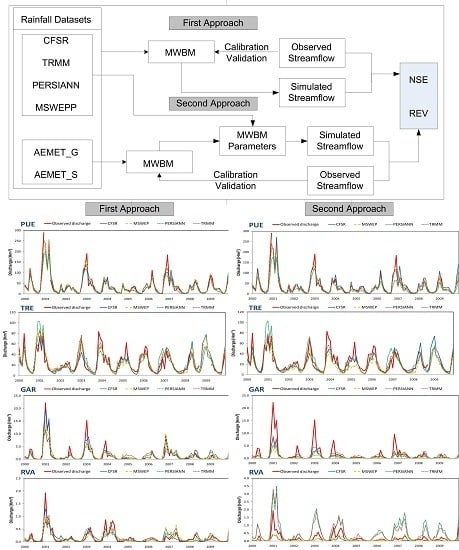Using Multiple Monthly Water Balance Models to Evaluate Gridded Precipitation Products over Peninsular Spain
Abstract
1. Introduction
2. Materials and Methods
2.1. Study Area
2.2. Datasets
2.2.1. TRMM Dataset
2.2.2. CFSR Dataset
2.2.3. PERSIANN Dataset
2.2.4. MSWEP Dataset
2.2.5. AEMET Dataset
2.2.6. Rain Gauge Data
3. Materials and Methods
3.1. Monthly Water Balance Models
- Thornthwaite-Mather (THM): It was developed in the early 1940s for the Delaware River, and several MWBMs are based on it. Based on the study of the model done by Alley [41], this model has two parameters (storage constant and soil moisture capacity) and two storages.
- ABCD: It is composed of two storages. It is characterised by allowing streamflow to occur even under conditions of moisture deficit [42]. It has four parameters and emerges as a tool for assessment of water resources in the United States.
- AWBM: It uses three storages to simulate partial surface run-off areas. The water balance in each of these storages is determined separately, using a total of six parameters [27]. It was developed in the 90s and today is one of the most widely used in Australia.
- GR2M: It is an evolution of the GR2 model that provides a simplified representation of the rainfall/runoff process. It is characterised by a small number of parameters, developed with empirical criteria, which do not correspond to specific physical attributes. This model is composed of four parameters and two storages. The model has been tested in numerous French stations. The description of this MWBM can be found in the work of Makhlouf and Michel [43].
- Guo: Described in [31,32], this MWBM is an adaptation of the model of Thornthwaite and Mather [44], increasing the number of parameters up to five. It has been applied in different sub-basins of the Dongjiang, in southern China, with good results. Xiong and Guo [31] compare it with the two-parameter model, concluding similar behaviour in practice.
- Témez (TEM): It is a purely empirical model that has been widely used in many Spanish basins, especially for assessment of water resources developed by the Hydrographical Study Centre. The model considers the land to be divided into two zones: Upper unsaturated, or soil moisture, and lower saturated, or aquifer, which functions as an underground reservoir that drains into the network of channels [45]. This model uses four parameters. It is a lumped model that has been applied in a distributed way in order to obtain an evaluation of the Spanish water resources [46].
3.2. MWBM Calibration and Validation Strategy
3.3. Performance of GPDs in Simulating Streamflow
3.4. Statistical Analysis
4. Results
4.1. Comparison of Areal Mean Rainfalls
4.2. Evaluation of the Simulated Streamflow Using MWBM
4.3. Evaluation of GPDs Using the AEMET_G-Calibrated GR2M
5. Discussion
6. Conclusions
- The results underscore the superiority of the national gridded dataset over the other rainfall remote sensing products examined in this study.
- The use of point-scale gauge records can lead to important deviations in areal precipitations, especially the drier the watershed is.
- The better estimation of volumes of precipitation by using MSWEP would possibly be due to its finer resolution. However, that is not altogether necessary for success in better streamflow forecast.
- The precipitation volumes of the GPDs tend to be smaller than those of the gauged data. However, PERSIANN and TRMM datasets show volumes higher than gauged records in semi-arid watersheds.
- The lumped GR2M model provides a better streamflow forecast than the other MWBMs in Peninsular Spain watersheds. Notwithstanding, the performance of GPDs and MWBMs highly depends on the climate: The more humid the watershed is, the better results can be achieved.
- When using GPDs in MWBM parameter calibration, TRMM rainfall data provides the best performance in simulating streamflow, with satisfactory precision in all watersheds according to NSE. However, CFSR achieves better results with regard to total volume recorded in sub-humid watersheds.
- Calibration achieved directly with GPDs could result in unrealistic parameter values in MWBMs to compensate for the large errors in input datasets. Thus, an assessment of previously fitted value parameters should be taken in account. Likewise, a study of MWBM performance and best fitted parameters with rain gauge data should be used with GPDs, in order to avoid invalid or extreme parameter values in MWBMs.
- When using rain gauge grid dataset-fitted parameters in MWBMs, TRMM was also the best GPD in humid and sub-humid watersheds, but its performance loses effectiveness the more arid the watershed is, as the rest of the GPDs showed, especially in peak flows, due to both the underestimation and overestimation of the extreme gauge precipitation in semi-arid watersheds.
- The uneven distribution of precipitation in semi-arid watersheds seems to be the reason why the performance of datasets and models is worse than in humid and sub-humid regions.
- Because semi-arid watersheds do not seem to provide very good results with the MWBMs and GPDs used, and because satellite rainfall datasets continue to improve, further analysis with other satellite data products and the joint use of (semi-) distributed models and downscaling datasets [65] are recommended for future studies, according to the methodology followed in developing this study. Likewise, sequential data assimilation techniques [66] may improve current hydrology model outputs using real-time observations.
Author Contributions
Acknowledgments
Conflicts of Interest
References
- Sun, Q.; Miao, C.; Duan, Q.; Ashouri, H.; Sorooshian, S.; Hsu, K.-L. A review of global precipitation data sets: Data sources, estimation, and intercomparisons. Rev. Geophys. 2018, 56. [Google Scholar] [CrossRef]
- Liu, X.; Yang, T.; Hsu, K.; Liu, C.; Sorooshian, S. Evaluating the streamflow simulation capability of PERSIANN-CDR daily rainfall products in two river basins on the Tibetan Plateau. Hydrol. Earth Syst. Sci. 2017, 21, 169–181. [Google Scholar] [CrossRef]
- Infante-Corona, J.A.; Lakhankar, T.; Pradhanang, S.; Khanbilvardi, R. Remote Sensing and Ground-Based Weather Forcing Data Analysis for Streamflow Simulation. Hydrology 2014, 1, 89–111. [Google Scholar] [CrossRef]
- Tang, G.; Behrangi, A.; Long, D.; Li, C.; Hong, Y. Accounting for spatiotemporal errors of gauges: A critical step to evaluate gridded precipitation products. J. Hydrol. 2018, 559. [Google Scholar] [CrossRef]
- Villarini, G.; Mandapaka, P.; Krajewski, V.; Witold, F.; Moore, R. Rainfall and sampling uncertainties: A rain gauge perspective. J. Geophys. Res. Atmos. 2008. [Google Scholar] [CrossRef]
- Jensen, N.E.; Pedersen, L. Spatial Variability of Rainfall. Variations within a Single Radar Pixel. J. Atmos. Res. 2005, 77, 269–277. [Google Scholar] [CrossRef]
- Wood, S.J.; Jones, D.A.; Moore, R. Accuracy of rainfall measurement for scales of hydrological interest. Hydrol. Earth Syst. Sci. 2000, 4, 531–543. [Google Scholar] [CrossRef]
- Tan, M.L.; Gassman, P.W.; Cracknell, A.P. Assessment of Three Long-Term Gridded Climate Products for Hydro-Climatic Simulations in Tropical River Basins. Water 2017, 9, 229. [Google Scholar] [CrossRef]
- Faramarzi, M.; Srinivasan, R.; Iravani, M.; Bladon, K.D.; Abbaspour, K.C.; Zehnder, A.J.B.; Goss, G.G. Setting up a hydrological model of Alberta: Data discrimination analyses prior to calibration. Environ. Model. Softw. 2015, 74, 48–65. [Google Scholar] [CrossRef]
- Raimonet, M.; Oudin, L.; Thieu, V.; Silvestre, M.; Vautard, R.; Rabouille, C.; Le Moigne, P. Evaluation of Gridded Meteorological Datasets for Hydrological Modeling. J. Hydrometeorol. 2017, 18, 3027–3041. [Google Scholar] [CrossRef]
- Huffman, G.J.; Bolvin, D.T.; Nelkin, E.J.; Wolff, D.B.; Adler, R.F.; Gu, G.; Stocker, E.F. The TRMM Multisatellite Precipitation Analysis (TMPA): Quasi-global, multiyear, combined-sensor precipitation estimates at fine scales. J. Hydrometeorol. 2007, 8, 38–55. [Google Scholar] [CrossRef]
- Ashouri, H.; Hsu, K.-L.; Sorooshian, S.; Braithwaite, D.K.; Knapp, K.R.; Cecil, L.D.; Prat, O.P. PERSIANN-CDR: Daily precipitation climate data record from multi-satellite observations for hydrological and climate studies. Bull. Am. Meteorol. Soc. 2015, 96, 69–83. [Google Scholar] [CrossRef]
- Beck, H.E.; van Dijk, A.I.J.M.; Levizzani, V.; Schellekens, J.; Miralles, D.G.; Martens, B.; de Roo, A. MSWEP: 3-hourly 0.25° global gridded precipitation (1979–2015) by merging gauge, satellite, and reanalysis data. Hydrol. Earth Syst. Sci. 2017, 21, 589–615. [Google Scholar] [CrossRef]
- Beck, H.E.; Vergopolan, N.; Pan, M.; Levizzani, V.; van Dijk, A.I.J.M.; Weedon, G.P.; Brocca, L.; Pappenberger, F.; Huffman, G.J.; Wood, E.F. Global-scale evaluation of 22 precipitation datasets using gauge observations and hydrological modeling. Hydrol. Earth Syst. Sci. 2017, 21, 6201–6217. [Google Scholar] [CrossRef]
- Saha, S.; Moorthi, S.; Wu, X.; Wang, J.; Nadiga, S.; Tripp, P.; Behringer, D.; Hou, Y.T.; Chuang, H.Y.; Iredell, M. The NCEP climate forecast system version 2. J. Clim. 2014, 27, 2185–2208. [Google Scholar] [CrossRef]
- Hyun-Goo, K.; Jin-Young, K.; Yong-Heack, K. Comparative Evaluation of the Third-Generation Reanalysis Data for Wind Resource Assessment of the Southwestern Offshore in South Korea. Atmosphere 2018, 9, 73. [Google Scholar] [CrossRef]
- Yang, Y.; Wang, G.; Wang, L.; Yu, J.; Xu, Z. Evaluation of Gridded Precipitation Data for Driving SWAT Model in Area Upstream of Three Gorges Reservoir. PLoS ONE 2014, 9, 11. [Google Scholar] [CrossRef] [PubMed]
- Xu, H.; Xu, C.Y.; Sælthun, N.R.; Zhou, B.; Xu, Y. Evaluation of reanalysis and satellite-based precipitation datasets in driving hydrological models in a humid region of southern China. Stoch. Environ. Res. Risk Assess. 2015, 29, 2003–2020. [Google Scholar] [CrossRef]
- Dos Reis, J.B.C.; Rennó, C.D.; Lopes, E.S.S. Validation of Satellite Rainfall Products over a Mountainous Watershed in a Humid Subtropical Climate Region of Brazil. Remote Sens. 2017, 9, 1240. [Google Scholar] [CrossRef]
- Seneviratne, S.I.; Corti, T.; Davin, E.L.; Hirschi, M.; Jaeger, E.B.; Lehner, I.; Orlowsky, B.; Teuling, A.J. Investigating soil moisture–climate interactions in a changing climate: A review. Earth Sci. Rev. 2010, 99, 125–161. [Google Scholar] [CrossRef]
- Hafeez, M.; van de Giesen, N.; Bardsley, E.; Seyler, F.; Pail, R.; Taniguchi, M. GRACE, Remote Sensing and Ground-Based Methods in Multi-Scale Hydrology: Proceedings of Symposium JHO1 Held during IUGG2011; IAHS Publications: Boulder, CO, USA, 2011; ISBN 978-1-907161-18-6. [Google Scholar]
- Wurbs, R.A. Texas water availability modeling system. J. Water Resour. Plan. Manag. 2005, 131, 270–279. [Google Scholar] [CrossRef]
- Sitterson, J.; Knightes, C.; Parmar, R.; Wolfe, K.; Muche, M.; Avant, B. An Overview of Rainfall-Runoff Model Types. EPA 2017 Office of Research and Development (8101R) Washington, DC 20460. Available online: https://cfpub.epa.gov/si/si_public_file_download.cfm?p_download_id=533906 (accessed on 5 June 2018).
- Pérez-Sánchez, J.; Senent-Aparicio, J.; Segura-Méndez, F.; Pulido-Velázquez, D. Assessment of lumped hydrological balance models in Peninsular Spain. Hydrol. Earth Syst. Sci. Discuss. 2017, 424. [Google Scholar] [CrossRef]
- Marinou, P.G.; Feloni, E.G.; Tzoraki, O.; Baltas, E.A. An implementation of a water balance model in the Evrotas basin. EWRA 2017, 57, 147–154. [Google Scholar]
- Wriedt, G.; Bouraoui, F. Towards a General Water Balance Assessment of Europe; Joint Research Centre—Institute for Environment and Sustainability; Office for Official Publications of the European Communities: Luxembourg, 2009. [Google Scholar]
- Boughton, W.C. The Australian water balance model. Environ. Model. Softw. 2004, 19, 943–956. [Google Scholar] [CrossRef]
- Zhang, Q.; Liu, J.; Singh, V.P.; Gu, X.; Chen, X. Evaluation of impacts of climate change and human activities on streamflow in the Poyang Lake basin, China. Hydrol. Process. 2016, 30, 2562–2576. [Google Scholar] [CrossRef]
- Sharifi, M.A.; Rodriguez, E. Design and development of a planning support system for policy formulation in water resources rehabilitation: The case of Alcázar De San Juan District in Aquifer 23, La Mancha, Spain. J. Hydroinform. 2002, 4, 157–175. [Google Scholar] [CrossRef]
- Barros, R.; Isidoro, D.; Aragüés, R. Long-term water balances in La Violada irrigation district (Spain): I. Sequential assessment and minimization of closing errors. Agric. Water Manag. 2011, 102, 35–45. [Google Scholar] [CrossRef]
- Xiong, L.; Guo, S. A two-parameter monthly water balance model and its application. J. Hydrol. 1999, 216, 111–123. [Google Scholar] [CrossRef]
- Guo, S. Impact of Climate Change on Hydrological Balance and Water Resource Systems in the Dongjiang Basin, China; Modeling and Management of Sustainable Basin-Scale Water Resource Systems (Proceedings of a Boulder Symposium; ed. by S. P. Simonovic, Z. W. Kundzewicz, D. Rosbjerg & K. Takeuchi); IAHS Publications: Boulder, CO, USA, 1995. [Google Scholar]
- Escriva-Bou, A.; Pulido-Velazquez, M.; Pulido-Velazquez, D. Economic value of climate change adaptation strategies for water management in Spain’s Jucar basin. J. Water Res. Plan. ASCE 2017, 143. [Google Scholar] [CrossRef]
- MIMAM. Libro Blanco del Agua en España; Centro de Publicaciones del Ministerio de Medio Ambiente: Madrid, Spain, 2000. [Google Scholar]
- Estrela, T. Modelos Matemáticos Para la Evaluación de Recursos Hídricos; Centro de Estudios Hidrográficos y Experimentación de Obras Públicas: Madrid, Spain, 1992. [Google Scholar]
- Kottek, M.; Grieser, J.; Beck, C.; Rudolf, B.; Rubel, F. World map of the Köppen-Geiger climate classification. Meteorol. Z. 2006, 15, 259–263. [Google Scholar] [CrossRef]
- CEDEX. 2018. Available online: http://www.cedex.es (accessed on 20 April 2018).
- Radcliffe, D.E.; Mukundan, R. PRISM vs. CFSR Precipitation Data Effects on Calibration and Validation of SWAT Models. JAWRA J. Am. Water Resour. Assoc. 2016, 1–12. [Google Scholar] [CrossRef]
- Peral García, C.; Navascués Fernández-Victorio, B.; Ramos Calzado, P. Serie de Precipitación Diaria en Rejilla con Fines Climáticos. Nota Técnica 24 de AEMET; Spanish Meteorological Agency (AEMET): Madrid, Spain, 2017. [Google Scholar]
- Xu, C.Y.; Singh, V.P. A review on monthly water balance models for water resources investigations. Hydrol. Process. 1998, 12, 31–50. [Google Scholar]
- Alley, W.M. On the treatment of Evapotranspiration, Soil Moisture Accounting and Aquifer Recharge in Monthly Water Balance Models. Water Resour. Res. 1984, 20, 1137–1149. [Google Scholar] [CrossRef]
- Thomas, H.A. Improved Methods for National Water Assessment; Report, contract: WR 15249270; U.S. Water Resources Council: Washington, DC, USA, 1981.
- Makhlouf, Z.; Michel, C. A two-parameter monthly water balance model for french watersheds. J. Hydrol. 1994, 162, 299–318. [Google Scholar] [CrossRef]
- Thornthwaite, C.W.; Mather, J.R. Instructions and Tables for Computing Potential Evapotranspiration and the Water Balance; Publications in Climatology, 10.3; Drexel Institute: Centerton, NJ, USA, 1957. [Google Scholar]
- Témez, J.R. Modelo Matemático de Transformación "Precipitación-Aportación"; Asociación de Investigación Industrial Eléctrica (ASINEL): Madrid, Spain, 1977. [Google Scholar]
- Estrela, T.; Cabezas, F.; Estrada, F. La evaluación de los recursos hídricos en el Libro Blanco del Agua en España. Ingeniería del Agua 1999, 6, 125–138. [Google Scholar] [CrossRef]
- Gan, T.Y.; Dlamini, E.M.; Biftu, G.F. Effects of model complexity and structure, data quality, and objective functions on hydrologic modeling. J. Hydrol. 1997, 192, 81–103. [Google Scholar] [CrossRef]
- Fylstra, D.; Lasdon, L.; Watson, J.; Waren, A. Design and use of the Microsoft Excel Solver. Interfaces 1998, 28, 29–55. [Google Scholar] [CrossRef]
- Lasdon, L.S.; Waren, A.D.; Jain, A.; Ratner, M. Design and testing of a generalized reduced gradient code for nonlinear programming. ACM Trans. Math. Softw. 1978, 4, 34–50. [Google Scholar] [CrossRef]
- Zeweldi, D.A.; Gebremichale, M.; Downer, C.W. On CMORPH rainfall for streamflow simulation in a small, Hortonian watershed. J. Hydrometeorol. 2011, 12, 456–466. [Google Scholar] [CrossRef]
- Artan, G.; Gadain, H.; Smith, J.L.; Asante, K.; Bandaragoda, C.J.; Verdin, J.P. Adequacy of satellite derived rainfall data for streamflow modelling. Nat. Hazards 2007, 43, 167–185. [Google Scholar] [CrossRef]
- Yilmaz, K.K.; Hogue, T.S.; Hsu, K.L.; Sorooshian, S.; Gupta, H.V.; Wagener, T. Intercomparison of rain gauge, radar, and satellite-based precipitation estimates with emphasis on hydrologic forecasting. J. Hydrometeorol. 2005, 6, 497–517. [Google Scholar] [CrossRef]
- Bitew, M.M.; Gebremichael, M.; Ghebremichael, L.T.; Bayissa, Y.A. Evaluation of high resolution satellite rainfall products through streamflow simulation in a hydrological modeling of a Small Mountainous Watershed in Ethiopia. J. Hydrometeorol. 2012, 13, 338–350. [Google Scholar] [CrossRef]
- Habib, E.; Haile, A.T.; Sazib, N.; Zhang, Y.; Rientjes, T. Effect of bias correction of satellite-rainfall estimates on runoff simulations at the source of the Upper Blue Nile. Remote Sens. 2014, 6, 6688–6708. [Google Scholar] [CrossRef]
- Nash, J.E.; Sutcliffe, J.V. River flow forecasting through conceptual models. Part I—A discussion of principles. J. Hydrol. 1970, 10, 282–290. [Google Scholar] [CrossRef]
- Sidike, A.; Chen, X.; Liu, T.; Durdiev, K.; Huang, Y. Investigating alternative climate data sources for hydrological simulations in the upstream of the Amu Darya River. Water 2016, 8, 441. [Google Scholar] [CrossRef]
- Yoshimoto, S.; Amarnath, G. Applications of Satellite-Based Rainfall Estimates in Flood Inundation Modeling—A Case Study in Mundeni Aru River Basin, Sri Lanka. Remote Sens. 2017, 9, 998. [Google Scholar] [CrossRef]
- Pérez-Sánchez, J.; Senent-Aparicio, J.; Díaz-Palmero, J.M.; Cabezas-Cerezo, J.D. A comparative study of fire weather indices in a semiarid south-eastern Europe region. Case of study: Murcia (Spain). Sci. Total Environ. 2017, 15, 590–591, 761–774. [Google Scholar] [CrossRef] [PubMed]
- Caparoci Nogueira, S.M.; Moreira, M.A.; Lordelo Volpato, M.M. Evaluating Precipitation Estimates from Eta, TRMM and CHRIPS Data in the South-Southeast Region of Minas Gerais State—Brazil. Remote Sens. 2018, 10, 313. [Google Scholar] [CrossRef]
- Cao, Y.; Zhang, W.; Wang, W. Evaluation of TRMM 3B43 data over the Yangtze River Delta of China. Sci. Rep. 2018, 8, 5290. [Google Scholar] [CrossRef] [PubMed]
- Zambrano-Bigiarini, M.; Nauditt, A.; Birkel, C.; Verbist, K.; Ribbe, L. Temporal and spatial evaluation of satellite-based rainfall estimates across the complex topographical and climatic gradients of Chile. Hydrol. Earth Syst. Sci. 2017, 21, 1295–1320. [Google Scholar] [CrossRef]
- Dinku, T.; Ceccato, P.; Grover-Kopec, E.; Lemma, M.; Connor, S.J.; Ropelewski, C.F. Validation of satellite rainfall products over East Africa’s complex topography. Int. J. Remote Sens. 2007, 28, 1503–1526. [Google Scholar] [CrossRef]
- Karaseva, M.O.; Prakash, S.; Gairola, R.M. Validation of high-resolution TRMM-3B43 precipitation product using rain gauge measurements over Kyrgyzstan. Theor. Appl. Climatol. 2012, 108, 147–157. [Google Scholar] [CrossRef]
- Guo, R.; Liu, Y. Evaluation of Satellite Precipitation Products with Rain Gauge Data at Different Scales: Implications for Hydrological Applications. Water 2016, 8, 281. [Google Scholar] [CrossRef]
- Omranian, E.; Sharif, H.O. Evaluation of the Global Precipitation Measurement (GPM) Satellite Rainfall Products over the Lower Colorado River Basin, Texas. J. Am. Water Resour. Assoc. 2018. [Google Scholar] [CrossRef]
- Javaheri, A.; Nabatian, M.; Omranian, E.; Babbar-Sebens, M.; Noh, S.J. Merging Real-Time Channel Sensor Networks with Continental-Scale Hydrologic Models: A Data Assimilation Approach for Improving Accuracy in Flood Depth Predictions. Hydrology 2018, 5, 9. [Google Scholar] [CrossRef]
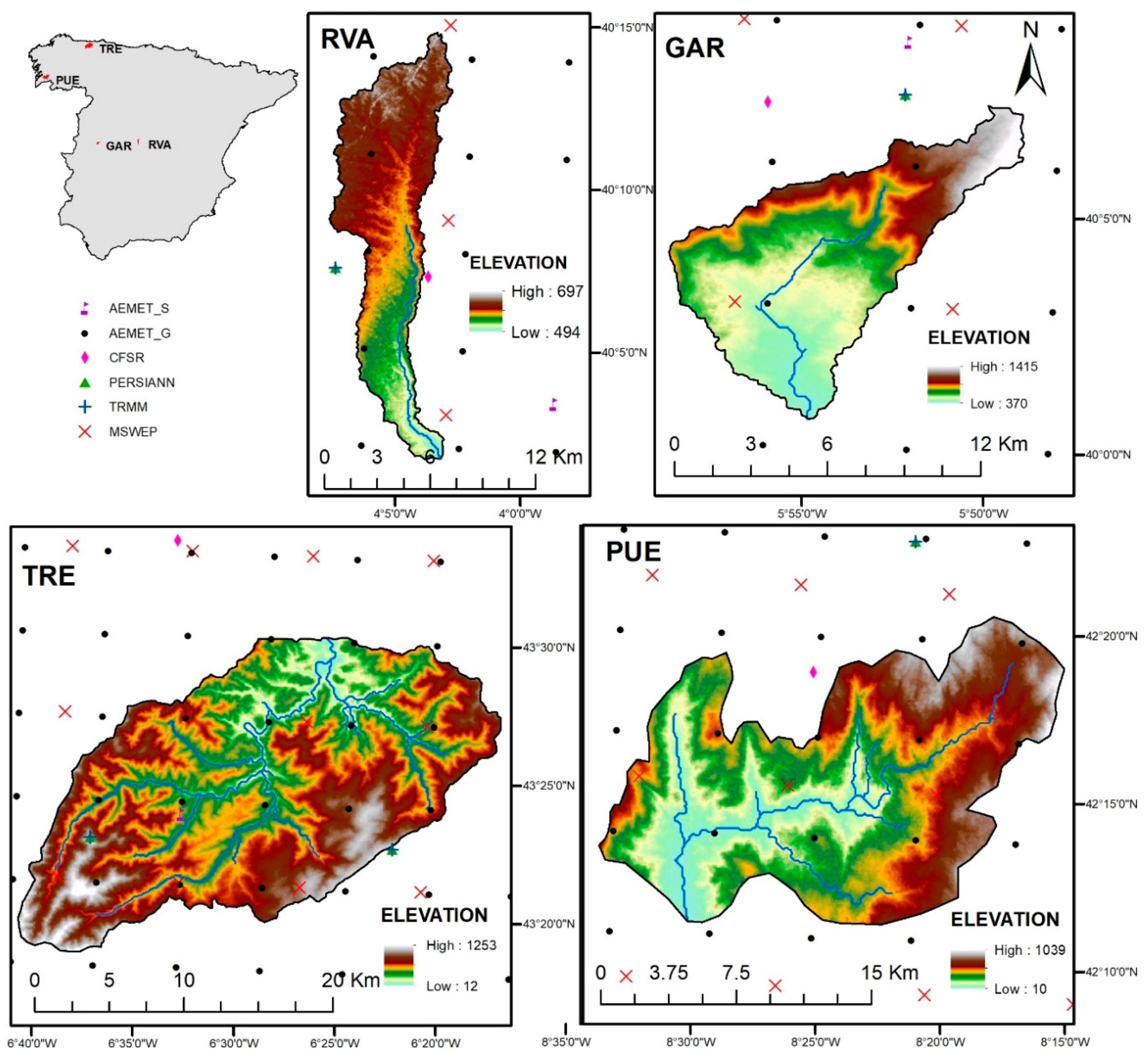



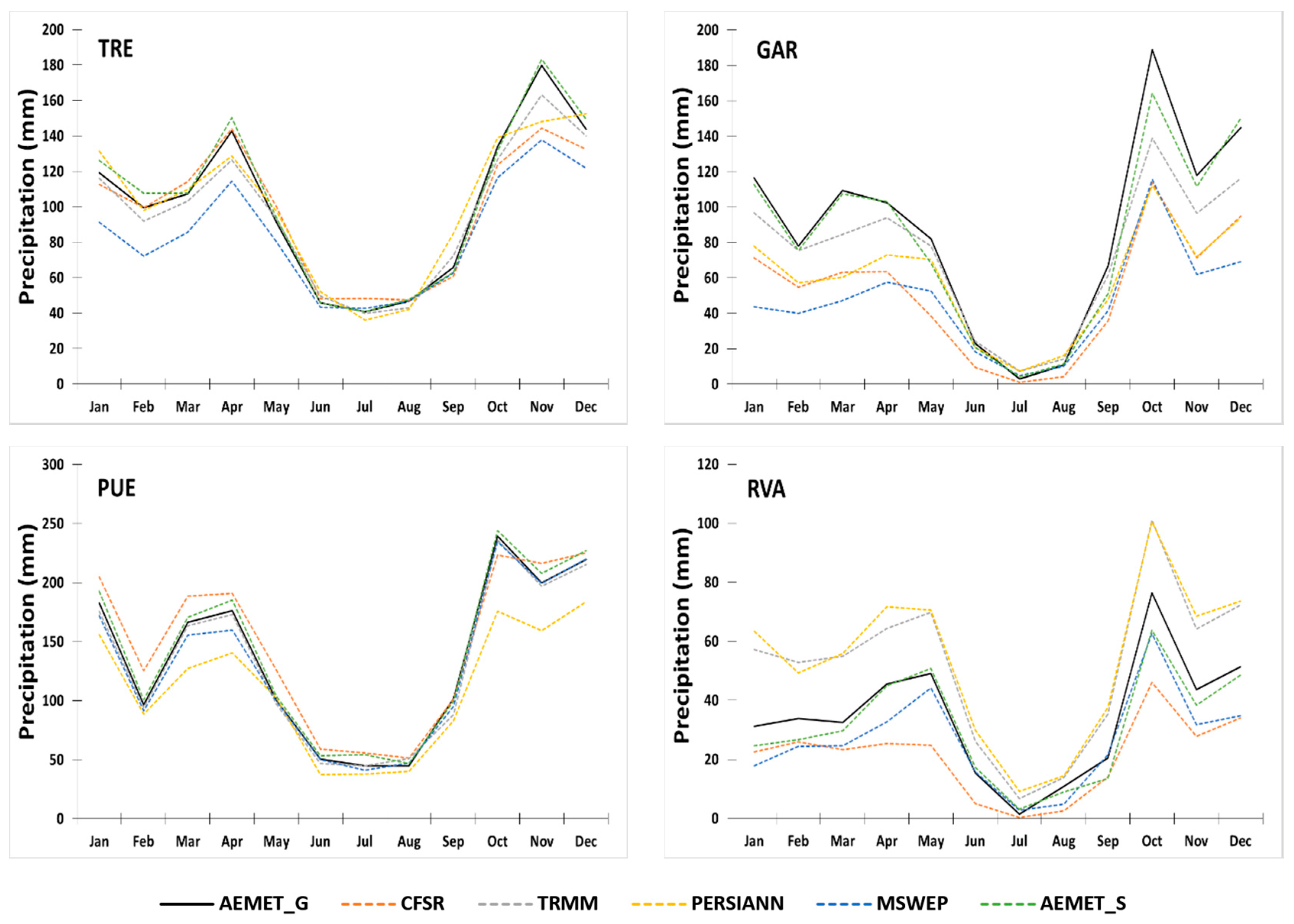
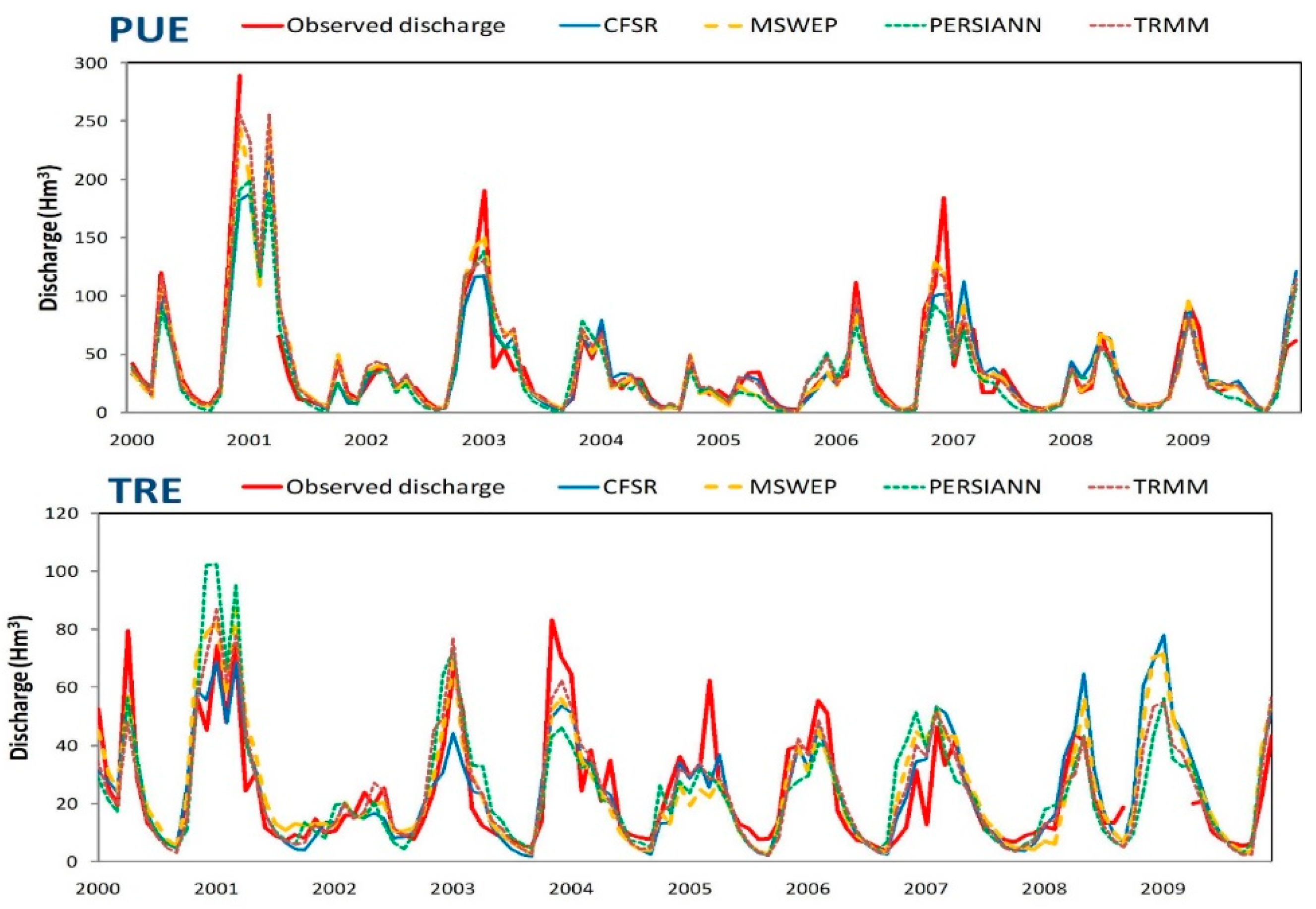

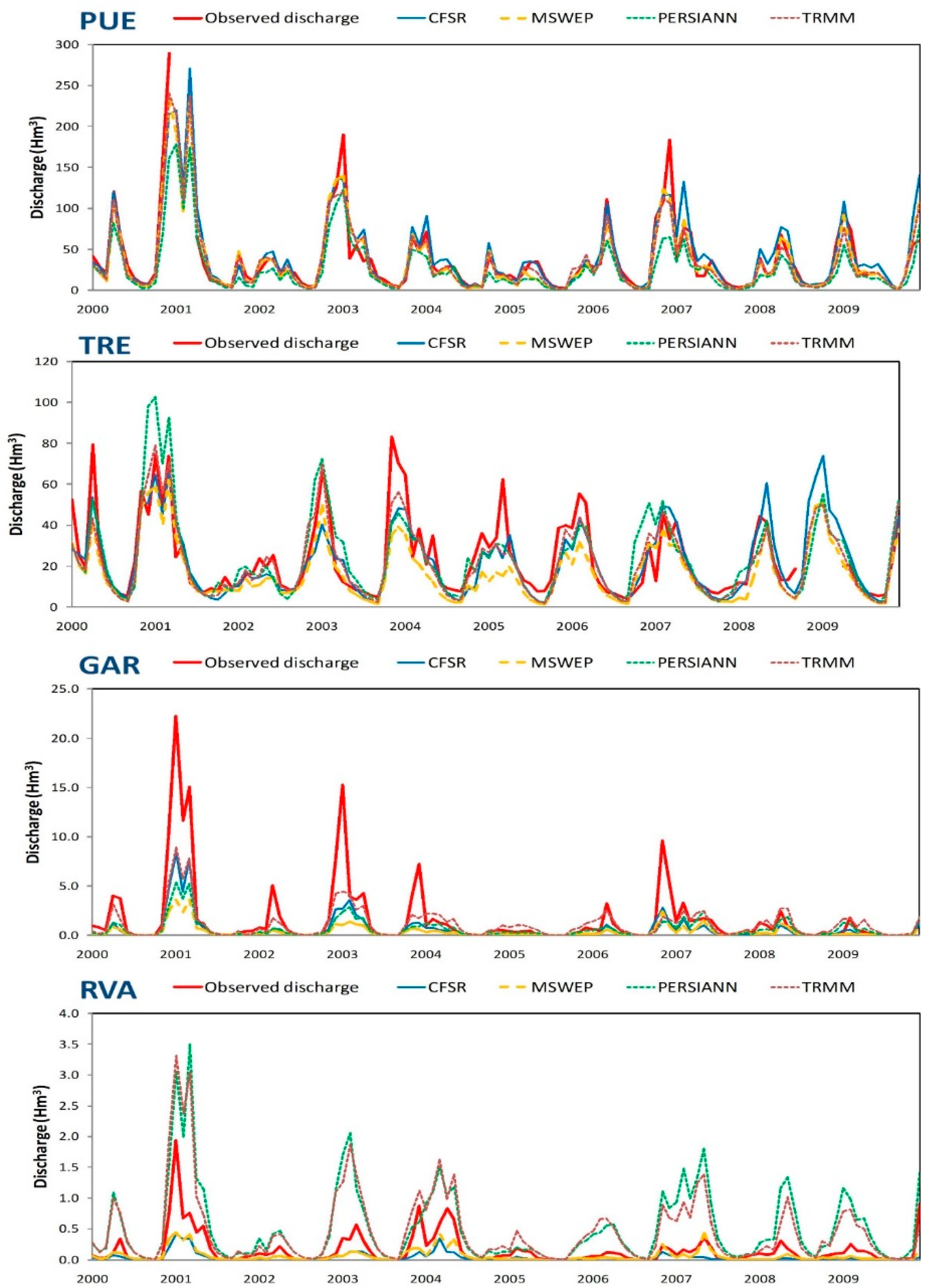
| Code | Area (km2) | Altitude (m.a.s.l) | Average Slope (%) | Köppen Classification | Average Precipitation (mm/year) | Average ETP (mm) | Average Flow (hm3/year) |
|---|---|---|---|---|---|---|---|
| RVA | 86 | 608 | 18.33 | Bsk | 422 | 1034 | 2.2 |
| GAR | 70 | 690 | 32.44 | Csa | 1081 | 1040 | 18.9 |
| PUE | 264 | 400 | 18.43 | Csb | 1624 | 762 | 435.2 |
| TRE | 414 | 527 | 7.51 | Cfb | 1241 | 674 | 300.9 |
| Dataset | Version | Spatial Resolution | Areal Coverage | Temporal Resolution | Temporal Coverage | Data Sources | Source |
|---|---|---|---|---|---|---|---|
| CFSR | DS093.1 | 0.3° × 0. 3° (≈38 km) | Global | Daily | 1979–present | Reanalysis | [15] |
| TRMM | 3B43 | 0.25° × 0.25° (≈30 km) | Latitude band 50°N–S | 3-hourly | 1998–present | Gauge, satellite | [11] |
| PERSIANN | CDR | 0.25° × 0.25° (≈30 km) | Latitude band 60°N–S | Daily | 1983–present | Gauge, satellite | [12] |
| MSWEP | V2.1 | 0.1° × 0.1° (≈12 km) | Global | 3-hourly | 1979–2016 | Gauge, satellite, reanalysis | [13] |
| AEMET_G | V1.0 | 5 km | Spain | Daily | 1951–2017 | Gauge | [39] |
| Basin Code | Station Name | Latitude | Longitude | Altitude (m.a.s.l) | Source |
|---|---|---|---|---|---|
| RVA | Recas | 39.96 | −4.01 | 609 | SIAR 1 |
| GAR | Valdastillas | 40.14 | −5.87 | 495 | REDAREX 2 |
| PUE | Vigo/Peinador | 42.24 | −8.62 | 261 | AEMET 3 |
| TRE | Zardain | 43.39 | −6.55 | 410 | AEMET |
| Basins | Dataset | R | RMSE (mm) | BIAS (%) |
|---|---|---|---|---|
| PUE | AEMET_S | 0.99 | 18.05 | −3.82 |
| TRMM | 0.99 | 18.58 | 2.53 | |
| PERSIANN | 0.97 | 48.01 | 17.94 | |
| CFSR | 0.98 | 30.77 | −8.90 | |
| MSWEP | 0.99 | 18.28 | 3.54 | |
| TRE | AEMET_S | 0.99 | 13.02 | −2.46 |
| TRMM | 0.96 | 20.68 | 4.19 | |
| PERSIANN | 0.83 | 39.34 | −0.27 | |
| CFSR | 0.94 | 23.15 | 3.43 | |
| MSWEP | 0.94 | 30.05 | 16.56 | |
| GAR | AEMET_S | 0.96 | 25.71 | 6.02 |
| TRMM | 0.95 | 41.19 | 14.88 | |
| PERSIANN | 0.95 | 55.73 | 32.00 | |
| CFSR | 0.95 | 53.65 | 40.39 | |
| MSWEP | 0.94 | 63.43 | 46.04 | |
| RVA | AEMET_S | 0.93 | 12.51 | 10.06 |
| TRMM | 0.95 | 22.28 | −50.29 | |
| PERSIANN | 0.91 | 25.97 | −56.53 | |
| CFSR | 0.88 | 21.34 | 38.88 | |
| MSWEP | 0.94 | 13.98 | 22.75 |
| Basin | Dataset | MWBM | ||||||
|---|---|---|---|---|---|---|---|---|
| ABCD | AWBM | GR2M | GUO | TEM | THM | Mean | ||
| PUE | AEMET_G | 0.65 | 0.65 | 0.95 | 0.70 | 0.69 | 0.65 | 0.71 |
| AEMET_S | 0.69 | 0.71 | 0.95 | 0.75 | 0.73 | 0.70 | 0.76 | |
| TRMM | 0.63 | 0.62 | 0.95 | 0.67 | 0.67 | 0.62 | 0.69 | |
| PERSIANN | 0.51 | 0.46 | 0.87 | 0.56 | 0.44 | 0.62 | 0.58 | |
| CFSR | 0.61 | 0.62 | 0.84 | 0.66 | 0.65 | 0.62 | 0.67 | |
| MSWEP | 0.64 | 0.63 | 0.95 | 0.69 | 0.67 | 0.64 | 0.70 | |
| Mean | 0.62 | 0.62 | 0.92 | 0.67 | 0.64 | 0.64 | ||
| TRE | AEMET_G | 0.86 | 0.79 | 0.86 | 0.83 | 0.82 | 0.82 | 0.83 |
| AEMET_S | 0.86 | 0.80 | 0.84 | 0.82 | 0.80 | 0.80 | 0.82 | |
| TRMM | 0.78 | 0.71 | 0.76 | 0.71 | 0.73 | 0.77 | 0.74 | |
| PERSIANN | 0.59 | 0.56 | 0.50 | 0.61 | 0.46 | 0.59 | 0.55 | |
| CFSR | 0.84 | 0.76 | 0.87 | 0.78 | 0.81 | 0.80 | 0.81 | |
| MSWEP | 0.78 | 0.64 | 0.78 | 0.71 | 0.73 | 0.77 | 0.73 | |
| Mean | 0.79 | 0.71 | 0.77 | 0.74 | 0.72 | 0.76 | ||
| GAR | AEMET_G | 0.89 | 0.98 | 0.92 | 0.89 | 0.90 | 0.86 | 0.91 |
| AEMET_S | 0.82 | 0.79 | 0.93 | 0.70 | 0.78 | 0.58 | 0.77 | |
| TRMM | 0.74 | 0.90 | 0.79 | 0.88 | 0.72 | 0.89 | 0.82 | |
| PERSIANN | 0.74 | 0.73 | 0.75 | 0.77 | 0.69 | 0.72 | 0.74 | |
| CFSR | 0.82 | 0.78 | 0.95 | 0.90 | 0.81 | 0.84 | 0.85 | |
| MSWEP | 0.63 | 0.62 | 0.39 | 0.54 | 0.63 | 0.90 | 0.60 | |
| Mean | 0.77 | 0.80 | 0.86 | 0.81 | 0.75 | 0.68 | ||
| RVA | AEMET_G | 0.71 | 0.81 | 0.81 | 0.57 | 0.39 | 0.56 | 0.64 |
| AEMET_S | 0.49 | 0.68 | 0.78 | 0.66 | 0.53 | 0.15 | 0.55 | |
| TRMM | 0.22 | 0.64 | 0.69 | 0.65 | 0.48 | 0.24 | 0.49 | |
| PERSIANN | 0.05 | 0.45 | 0.68 | 0.45 | 0.61 | 0.24 | 0.41 | |
| CFSR | 0.59 | 0.69 | 0.83 | 0.59 | 0.67 | 0.24 | 0.60 | |
| MSWEP | −0.26 | 0.68 | 0.78 | 0.50 | 0.68 | 0.09 | 0.41 | |
| Mean | 0.30 | 0.66 | 0.76 | 0.57 | 0.56 | 0.25 | ||
| Basin | Dataset | MWBM | |||||
|---|---|---|---|---|---|---|---|
| ABCD | AWBM | GR2M | GUO | TEM | THM | ||
| PUE | AEMET_G | −14.56 | −36.70 | +1.43 | −17.37 | −36.14 | −36.23 |
| AEMET_S | −8.07 | −31.58 | +6.60 | −12.03 | −30.30 | −31.46 | |
| TRMM | −15.72 | −38.10 | +3.26 | −17.49 | −37.30 | −38.26 | |
| PERSIANN | −31.91 | −52.47 | −14.53 | −28.59 | −51.57 | −29.89 | |
| CFSR | −22.95 | −34.91 | −12.30 | −23.09 | −35.41 | −35.20 | |
| MSWEP | −16.03 | −38.20 | +1.46 | −16.81 | −37.42 | −37.29 | |
| TRE | AEMET_G | −7.52 | −14.66 | −6.88 | −6.01 | −8.40 | −14.49 |
| AEMET_S | −5.74 | −13.97 | −9.56 | −8.97 | −9.01 | −3.39 | |
| TRMM | +3.31 | −4.70 | +5.86 | +9.17 | +0.62 | −2.94 | |
| PERSIANN | +6.00 | +10.43 | +12.14 | +8.76 | +12.14 | +11.26 | |
| CFSR | −3.03 | −11.37 | −3.08 | −3.02 | −4.85 | −10.88 | |
| MSWEP | +9.43 | −21.52 | +15.41 | +14.22 | −14.53 | −15.58 | |
| GAR | AEMET_G | −12.20 | −7.77 | −7.96 | −9.15 | −3.60 | +8.51 |
| AEMET_S | −3.39 | +2.89 | +7.89 | +13.39 | +19.53 | +26.08 | |
| TRMM | −33.31 | −26.30 | −28.18 | −28.04 | −22.48 | −17.09 | |
| PERSIANN | −34.02 | −46.62 | −35.89 | −43.06 | −39.56 | −42.96 | |
| CFSR | −28.17 | −26.42 | −1.59 | −21.08 | −21.60 | −28.02 | |
| MSWEP | −56.23 | −54.13 | −19.70 | −44.45 | −46.73 | −58.91 | |
| RVA | AEMET_G | −25.67 | +19.43 | −1.04 | +64.41 | +23.95 | +62.01 |
| AEMET_S | −29.22 | −9.19 | +12.97 | +44.64 | +38.43 | −22.71 | |
| TRMM | −25.58 | −34.69 | −10.59 | −22.91 | −16.43 | −26.10 | |
| PERSIANN | −44.34 | −47.75 | −16.30 | +36.21 | −19.19 | −30.01 | |
| CFSR | −21.18 | +54.91 | +20.33 | +59.41 | +45.42 | +119.72 | |
| MSWEP | −48.37 | +25.48 | −11.18 | +52.98 | +5.20 | −44.89 | |
| Basins | Dataset | NSE | REV (%) |
|---|---|---|---|
| PUE | AEMET_S | 0.87 | 8.18 |
| TRMM | 0.88 | −3.70 | |
| PERSIANN | 0.70 | −29.26 | |
| CFSR | 0.80 | 14.76 | |
| MSWEP | 0.89 | −3.45 | |
| TRE | AEMET_S | 0.82 | 0.99 |
| TRMM | 0.77 | −9.66 | |
| PERSIANN | 0.57 | −0.27 | |
| CFSR | 0.72 | −11.27 | |
| MSWEP | 0.58 | −30.67 | |
| GAR | AEMET_S | 0.90 | −0.91 |
| TRMM | 0.57 | −28.78 | |
| PERSIANN | 0.32 | −60.02 | |
| CFSR | 0.48 | −62.21 | |
| MSWEP | 0.17 | −77.13 | |
| RVA | AEMET_S | 0.61 | −31.72 |
| TRMM | −2.70 | 200.16 | |
| PERSIANN | −3.71 | 228.23 | |
| CFSR | 0.17 | −74.86 | |
| MSWEP | 0.33 | −60.47 |
© 2018 by the authors. Licensee MDPI, Basel, Switzerland. This article is an open access article distributed under the terms and conditions of the Creative Commons Attribution (CC BY) license (http://creativecommons.org/licenses/by/4.0/).
Share and Cite
Senent-Aparicio, J.; López-Ballesteros, A.; Pérez-Sánchez, J.; Segura-Méndez, F.J.; Pulido-Velazquez, D. Using Multiple Monthly Water Balance Models to Evaluate Gridded Precipitation Products over Peninsular Spain. Remote Sens. 2018, 10, 922. https://doi.org/10.3390/rs10060922
Senent-Aparicio J, López-Ballesteros A, Pérez-Sánchez J, Segura-Méndez FJ, Pulido-Velazquez D. Using Multiple Monthly Water Balance Models to Evaluate Gridded Precipitation Products over Peninsular Spain. Remote Sensing. 2018; 10(6):922. https://doi.org/10.3390/rs10060922
Chicago/Turabian StyleSenent-Aparicio, Javier, Adrián López-Ballesteros, Julio Pérez-Sánchez, Francisco José Segura-Méndez, and David Pulido-Velazquez. 2018. "Using Multiple Monthly Water Balance Models to Evaluate Gridded Precipitation Products over Peninsular Spain" Remote Sensing 10, no. 6: 922. https://doi.org/10.3390/rs10060922
APA StyleSenent-Aparicio, J., López-Ballesteros, A., Pérez-Sánchez, J., Segura-Méndez, F. J., & Pulido-Velazquez, D. (2018). Using Multiple Monthly Water Balance Models to Evaluate Gridded Precipitation Products over Peninsular Spain. Remote Sensing, 10(6), 922. https://doi.org/10.3390/rs10060922







